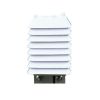Spectrum WatchDog A110 Temperature Logger
Features
- LCD display confirms logger operation and displays current sensor readings
- Select measurement intervals from 1 to 120 minutes
- Log 4,000 to 8,000 intervals in fail-safe EEPROM data memory
- Expedited repair and warranty service
- Lifetime technical support
- More
Overview
The Spectrum WatchDog A-Series loggers offer an affordable way to track environmental conditions for analysis. Removable soft caps keep ports clear of debris, and slide-out hangers make attachment simple. SpecWare 9 (Pro or Basic) and the A-Series PC Connection Cable are required. The Radiation Shield is also recommended.
Mechanics
An LCD display confirms logger operation and provides current sensor readings. A-Series Loggers have a logger capacity up to 8,000 measurements (4,000 per channel using both channels); Select measurement intervals from 1 to 120 minutes. A 30-minute interval will record for 111 days before the station’s memory is full. Data is stored in fail-safe, EEPROM memory.
Power
State-of-the-art low-power consumption electronics are supported by a 12-month battery power source (CR2 included). No solar panels to purchase and maintain.
In The News
Data-Driven Advocacy on the Lower Deschutes River
Like many freshwater environments, the Deschutes River in Oregon is under pressure from development, pollution, and climate change. Many rivers, streams and lakes in the Deschutes Basin do not meet Oregon water quality standards –where state water quality monitoring assesses levels of bacteria, pH, dissolved oxygen, temperature, and fine sediment. Hannah Camel is the Water Quality Coordinator for the Deschutes River Alliance (DRA), a non-profit organization that focuses on the health of the lower 100 miles of the Deschutes River–the area most affected by human intervention. As a data-driven organization, the DRA has benefited from the installation of two NexSens X2 data loggers.
Read MoreExpanding the Port Everglades: Real-Time Monitoring of Water Quality Conditions from Planned Dredging Operation
The Port Everglades in Broward County, Florida, serves large trade vessels and cruiseliners and incoming and outgoing recreational boaters. However, as cargo ships become larger, the port must expand. A dredging project led by the US Army Corps of Engineers will substantially deepen and widen the port's navigation channel to accommodate larger Panamax cargo ships and modern cruise liners. As a result of this project, a large amount of sediment will be displaced into the water column. This suspended sediment may settle outside of the project area, burying benthic organisms like corals, and possibly carrying harmful particulates to other regions. [caption id="attachment_39497" align="aligncenter" width="2560"] A CB-950 and CB-25 deployed on site at Port Everglades.
Read MoreIt’s Time to React to Water Quality: Proteus Multiparameter Probe aboard NexSens Buoy
Water quality monitoring is essential for safeguarding public health, protecting ecosystems, and ensuring the sustainability of water resources. Contaminants such as industrial pollutants, agricultural runoff, and sewage discharge can severely impact aquatic life and pose serious risks to human health if left unchecked. Traditionally, water quality monitoring has been a slow and labor-intensive process, requiring samples to be collected, transported to a lab, and analyzed—a process that can take days. However, with the advancement of real-time sensor technology, environmental agencies, researchers, and industries can now monitor water quality instantly.
Read More











